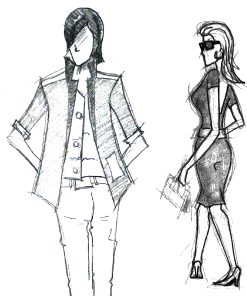
People have different personalities. So do buildings. Have you ever walked into a party and checked out the patrons? Each person has a personality. Ever walk down the street and look at the people? Ever walk down the street and look at the buildings? People usually dress in shoes, pants, skirts, shirts, sweaters or blouses, hats or hats. Could you take a closer look at a building? Is there a base or foundation where the building touches the ground? Is there a trunk, torso, or body of the building? Is there a waist or belt area? Is there a crown or hat area? Is their ornamentation? Do we dress for comfort or show? Is the building sustainable, timely, or timeless? Drawing, pattern-making, and construction occur in fashion design and architecture. Is fashion a lifestyle, a costume, a performance? Is architecture sculpture an event or a movement?
Is architecture fashion???
Activity 1 – Full Figure: Dress Me!

In this activity you will draw, drape, pattern-make and construct 4 sample garments. Investigate the idea of skin as a relationship between the body, material and identity. Examine the relationship between the body and space. Design for four seasons: winter, spring, summer, and fall. What materials will you choose for each season? Think about weight, color, and movement of material. Think about the weather and activities. Use material swatches that you can easily find, even natural materials. Visiting a sewing center is always exciting. Once you have created some sketch ideas and collected some potential materials, attempt to mock-up your garments using a friend or a figure doll or a form. Use tape, glue, staples, pins, stitches with needles and threads…just be cautious! Illustrate your four garments. Photo document the drawing and the construction side by side. Write a paragraph announcing your garment at a fashion show. Give your collection a name and ID the individual pieces. Be sure to include appropriate accessories like shoes, jewelry, etc.
Activity 2 – Full Figure: Dress a Building

Having researched and considered weather - temperature, humidity and air movement - when designing your seasonal fashion collection, take the same approach to a building. Take a picture of any building, or cut one out of the paper or a magazine. Make four or more copies of the building and label them one by one: spring, summer, winter , fall. Now using scraps left over from activity 1, dress your building. Think about how to apply materials for shade, warmth, transparency and effect. Don’t forget to consider people’s views and personal experiences inside of the building!
Activity 3 – Make a Hat Canopy

Can a canopy become a wearable shelter for people? Several recent airports have covered their passengers with tensile canopies. Denver International Airport, completed in 1994, features a series of tensile structures covering the entry. (image shared for educational purposes by Wikipedia Commons). Look at the Canopy Airport Portfolio to see many more examples. Find a canopy airport that you like and draw it!
Activity 4 – Wear a Wall
Pleating, folding, layering, wrapping are all verbs that can cover the body as well as coat space. Take a look at the work of Issey Miyaki Fashion Designer and Brooks Scarpa Architects. Look at how bodies and buildings are covered, shielded, wrapped. Pick on of the material transformations of the architect and transform its technique in creating something to wear. Next, pick something from Miyaki or another fashion designer and translate its techniques to the scale of a building. Transfer ideas about function, form and enclosure.
An architect can be a fashion designer!
Activity 5 – Wear a Shelter
When the weather changes, do you find yourself changing clothes? Do you wear a sweater or a jacket when the weather is cooler? Do you wear a raincoat when it rains? Do your hats, gloves, and shoes change with the weather? How does a building respond to changes in weather? It sheds rain with downspouts and sloped roofs. When the sun is too hot, it can close shutters, or open awnings. When the inside of a building is too hot, people can open windows for cross ventilation to bring in cool air. Research Indigenous housing and find out how early people built shelters to live in and then created shelters that could move when they needed to change locations for water or food.
Review

- Skin is a term that can be applied to an organ of the body and the surface of a building.
- Both architects and fashion designers work with the human form and body.
- Dressing for comfort is sustainable; dressing for fashion is not.
- Patterns are used in both architecture and fashion.
- Forms are artificial human figures used for draping cloth.
Explore
- 18th Century Clothing (Williamsburg)
- American Textile History Museum
- Brooks Scarpa Architects
- Chanel
- Digital Architecture Laboratory
- Dolce and Gabbano
- ECO EVIE
- Fashion Museum
- FAT Fashion Architecture Taste
- History of Costume Design
- Ian Schrager Company.com
- Issey Miyake
- Pockets of History
- Prada
- Ralph Lauren
- The ABCs of Architecture...so fashionable!
- TOM's One for One



















































